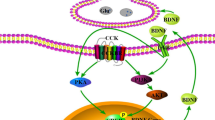Summary
Cholecystokinin (CCK) is a peptide that can be found in the cerebral cortex in high concentrations and is involved in learning and memory as well as neurodegenerative processes. Cortical brain samples from 9 patients with Alzheimer's disease and 9 matched control cases were studied with respect to the concentrations of various molecular forms of CCK and the CCK receptor binding characteristics. No differences were found between patients and controls in any of these measures. Significant correlations were found between the concentrations of CCK-8 sulphated and the three nonsulphated CCK peptides measured. In addition, the concentrations of CCK-4 and CCK-5 showed a highly significant and positive correlation.
Similar content being viewed by others
References
Adolfsson R, Gottfries CG, Nyström L, Winblad B (1981) Prevalence of dementia disorders in institutionalized Swedish old people. The workload imposed by caring for these patients. Acta Psychiatr Scand 63: 225–244
Akaike A, Tamura Y, Sato Y, Ozaki K, Matsuoka R, Miura S, Yoshinaga T (1991) Cholecystokinin-induced protection of cultured cortical neurons against glutamate neurotoxicity. Brain Res 557: 303–307
Baber NS, Dourish C, Hill DR (1989) The role of CCK, caerulein and CCK antagonists in nociception. Pain 39: 307–328
Beinfeld MC, Meyer DK, Eskay RL, Jensen RT, Brownstein MJ (1981) The distribution of cholecystokinin immunoreactivity in the central nervous system of the rat as determined by radioimmunoassay. Brain Res 212: 51–57
Cantor P, Rehfeld JF (1985) Radioimmunoassay of cholecystokinin: comparison of different tracers. J Immunol Methods 82: 47–55
Chard T (1982) An introduction to radioimmunoassay and related techniques, 2nd edn. Elsevier Biomedical Press, Amsterdam
Harro J, Oreland L (1992) Age-related differences of cholecystokinin receptor binding in the rat brain. Prog Neuropsychopharmacol Biol Psychiatry 16: 369–375
Harro J, Marcusson J, Oreland L (1992) Alterations in brain cholecystokinin receptors in suicide victims. Eur Neuropsychopharmacol 2: 57–63
Harro J, Vasar E, Bradwejn J (1993a) CCK in animal and human research on anxiety. Trends Pharmacol Sci 14: 244–249
Harro J, Westerling P, Oreland L (1993b) CCK B receptor activation reduces glutamate-induced depolarization in slices of rat cerebral cortex. J Neural Transm [Gen Sect] 93: 61–66
Hays SE, Paul SM (1982) CCK receptors and human neurological disease. Life Sci 31: 319–322
Katsuura G, Shinohara S, Shintaku H, Eigyo M, Matsushita A (1991) Protective effect of CCK-8 and ceruletide on glutamate-induced neuronal cell death in rat neuron cultures: possible involvement of CCK-B receptors. Neurosci Lett 132: 159–162
Khachaturian ZS (1985) Diagnosis of Alzheimer's disease. Arch Neurol 42: 1097–1105
Kovacs GL, de Wied D (1994) Peptidergic modulation of learning and memory processes. Pharmacol Rev 46: 269–291
Leatherbarrow RJ (1987) Enzfitter, a non-linear regression data analysis program for the IBM PC. Elsevier Science Publishers, Amsterdam
Luna LG (1960) Manual of histological staining methods of the Armed Forces Institute of Pathology, 3rd edn. McGraw-Hill, New York
Markwell MAK, Haas SM, Bieber LL, Tolbert NE (1978) A modification of the Lowry procedure to simplify protein determination in membrane and lipoprotein samples. Anal Biochem 87: 206–210
Mazurek FM, Beal MF (1991) Cholecystokinin and somatostatin in Alzheimer's disease postmortem cererbral cortex. Neurology 41: 716–719
McKhann G, Drachman D, Polstein M, Katzman R, Price D, Stadian E (1984) Clinical diagnosis of Alzheimer's disease: report of the NINCDS-ADRDA Work Group under the auspices of Department of Health and Human Services task force on Alzheimer's disease. Neurology 34: 939–944
Moran TH, Robinson PH, Goldrich MS, McHugh PR (1986) Two brain cholecystokinin receptors: implications for behavioral actions. Brain Res 362: 175–179
Morley JE (1987) Behavioral effects of administered cholecystokinin. ISI Atlas Pharmacol 1: 49–51
Perry EK, Blessed G, Tomlinson BE, Perry RH, Crow TJ, Cross AJ, Dockray GJ, Dimaline R, Arregui A (1981) Neurochemical activities in human temporal lobe related to aging and Alzheimer-type changes. Neurobiol Aging 2: 251–256
Rehfeld JF, Hansen HF (1986) Characterization of preprocholecystokinin products in the porcine cerebral cortex. J Biol Chem 261: 5832–5840
Rossor MN, Rehfeld JF, Emson PC, Mountjoy CQ, Roth M, Iversen LL (1981) Normal cortical concentration of cholecystokinin-like immunoreactivity with reduced choline acetyltransferase actitvity in senile dementia of Alzheimer type. Life Sci 29: 405–410
Sagar SM, Beal MF, Marshall PE, Landis DMD, Martin JB (1984) Implications of neuropeptides in neurological diseases. Peptides 5: 255–262
Woodruff GN, Hughes J (1991) Cholecystokinin antagonists. Annu Rev Pharmacol Toxicol 31: 469–501
Author information
Authors and Affiliations
Rights and permissions
About this article
Cite this article
Löfberg, C., Harro, J., Gottfries, C.G. et al. Cholecystokinin peptides and receptor binding in Alzheimer's disease. J. Neural Transmission 103, 851–860 (1996). https://doi.org/10.1007/BF01273363
Received:
Accepted:
Issue Date:
DOI: https://doi.org/10.1007/BF01273363




